Imagination Announces B-Series GPU IP: Scaling up with Multi-GPU
by Andrei Frumusanu on October 13, 2020 4:00 AM EST- Posted in
- GPUs
- Imagination Technologies
- SoCs
- IP
Configurations - Up to 4 GPUs at 6TFLOPs
Starting off with the smallest GPU building blocks, it’s good to remind ourselves how an Imagination GPU looks like – the following is from last year’s A-Series presentation:
| PowerVR GPU Comparison | ||||
| AXT-16-512 BXT-16-512 |
GT9524 | GT8525 | GT7200 Plus | |
| Core Configuration |
1 SPU (Shader Processing Unit) - "GPU Core" 2 USCs (Unified Shading Clusters) - ALU Clusters |
|||
| FP32 FLOPS/Clock MADD = 2 FLOPs MUL = 1 FLOP |
512 (2x (128x MADD)) |
240 (2x (40x MADD+MUL)) |
192 (2x (32x MADD+MUL)) |
128 (2x (16x MADD+MADD)) |
| FP16 Ratio | 2:1 (Vec2) | |||
| Pixels / Clock | 8 | 4 | ||
| Texels / Clock | 16 | 8 | 4 | |
| Architecture | A-Series B-Series |
Series-9XTP (Furian) |
Series-8XT (Furian) |
Series-7XT (Rogue) |
Fundamentally and at a high-level, the new B-Series GPU microarchitecture looks very similar to the A-Series. Microarchitecturally, Imagination noted that we should generally expect a 15% increase in performance or increase in efficiency compared to the A-Series, with the building blocks of the two GPU families being generally the same save for some more important additions such as the new IMGIC (Imagination Image Compression) implementation which we’ll cover in a bit.
An XT GPU still consists of the new SPU design which houses the new more powerful TPU (Texture Processing Unit) as well as the new 128-wide ALU designs that is scaled into ALU clusters called USCs (Unified Shading Clusters).
Imagination’s current highest-end hardware implementation in the BXT series is the BXT 32-1024, and putting four of these together creates an MC4 GPU. In a high-performance implementation reaching up to 1.5GHz clock speeds, this configuration would offer up to 6TFLOPs of FP32 computing power. Whilst this isn’t quite enough to catch up to Nvidia and AMD, it’s a major leap for a third-party GPU IP provider that’s been mostly active in the mobile space for the last 15 years.
The company’s BXM series continues to see a differentiation in the architecture as some of its implementations do not use the ultra-wide ALU design of the XT series. For example, while the BXM-8-256 uses one 128-wide USC, the more area efficient BXM 4-64 for example continues to use the 32-wide ALU from the 8XT series. Putting four BXM-4-64 GPUs together gets you to a higher performance tier with a better area and power efficiency compared to a larger single GPU implementation.
The most interesting aspect of the multi-GPU approach is found in the BXE series, which is Imagination’s smallest GPU IP that purely focuses on getting to the best possible area efficiency. Whilst the BXT and BXM series GPUs until now are delivered as “primary” cores, the BXE is being offered in the form of both a primary as well as a secondary GPU implementation. The differences here is that the secondary variant of the IP lacks a firmware processor as well as a geometry processing, instead fully relying on the primary GPU’s geometry throughput. Imagination says that this configuration would be able to offer quite high compute and fillrate capabilities in extremely minuscule area usage.
| PowerVR Hardware Designs GPU Comparison | ||||||
| Family | Texels/ Clock |
FP32/ Clock |
Cores | USCs | Wavefront Width |
MC Design |
| BXT-32-1024 MC1 | 32 | 1024 | 1 | 4 | 128 | P |
| BXT-16-512 MC1 | 16 | 512 | 1 | 2 | 128 | P |
| BXM-8-256 MC1 | 8 | 256 | 1 | 1 | 128 | P |
| BXM-4-64 MC1 | 4 | 64 | 1 | 1 | 32 | P |
| BXE-4-32 Secondary | 4 | 32 | 1 | 1 | 16 | S |
| BXE-4-32 MC1 | 4 | 32 | 1 | 1 | 16 | P |
| BXE-2-32 MC1 | 2 | 32 | 1 | 1 | 16 | P |
| BXE-1-16 MC1 | 1 | 16 | 1 | 1 | 8 | P |
Putting the different designs into a table, we’re seeing only 8 different hardware designs that Imagination has to create the RTL and do physical design and timing closure on. This is already quite a nice line-up in terms of scaling from the lowest-end area focused IP to something that would be used in a premium high-end mobile SoC.
| PowerVR MC GPU Configurations | ||||||
| Family | Texels/ Clock |
FP32/ Clock |
Cores | USCs | Wavefront Width |
MC Design |
| BXT-32-1024 MC4 | 128 | 4096 | 4 | 16 | 128 | PPPP |
| BXT-32-1024 MC3 | 96 | 3072 | 3 | 12 | 128 | PPP |
| BXT-32-1024 MC2 | 64 | 2048 | 2 | 8 | 128 | PP |
| BXT-32-1024 MC1 | 32 | 1024 | 1 | 4 | 128 | P |
| BXT-16-512 MC1 | 16 | 512 | 1 | 2 | 128 | P |
| BXM-8-256 MC1 | 8 | 256 | 1 | 1 | 128 | P |
| BXM-4-64 MC4 | 16 | 256 | 4 | 4 | 32 | PPPP |
| BXM-4-64 MC3 | 12 | 192 | 3 | 3 | 32 | PPP |
| BXM-4-64 MC2 | 8 | 128 | 2 | 2 | 32 | PP |
| BXM-4-64 MC1 | 4 | 64 | 1 | 1 | 32 | P |
| BXE-4-32 MC4 | 16 | 128 | 4 | 4 | 16 | PSSS |
| BXE-4-32 MC3 | 12 | 96 | 3 | 3 | 16 | PSS |
| BXE-4-32 MC2 | 8 | 64 | 2 | 2 | 16 | PS |
| BXE-4-32 MC1 | 4 | 32 | 1 | 1 | 16 | P |
| BXE-2-32 MC1 | 2 | 32 | 1 | 1 | 16 | P |
| BXE-1-16 MC1 | 1 | 16 | 1 | 1 | 8 | P |
The big flexibility gain for Imagination and their customers is that they can simple take one of the aforementioned hardware designs, and scale these up seamlessly by laying out multiple GPUs. On the low-end, this creates some very interesting overlaps in terms of compute abilities, but offer different fillrate capabilities at different area efficiency options.
At the high-end, the biggest advantage is that Imagination can quadruple their processing power from their biggest GPU configuration. Imagination notes that for the BXT series, they no longer created a single design larger than the BXT-32-1024 because the return on investment would simply be smaller, and involve more complex timing work than if a customer would simply scale performance up via a multi-core implementation.


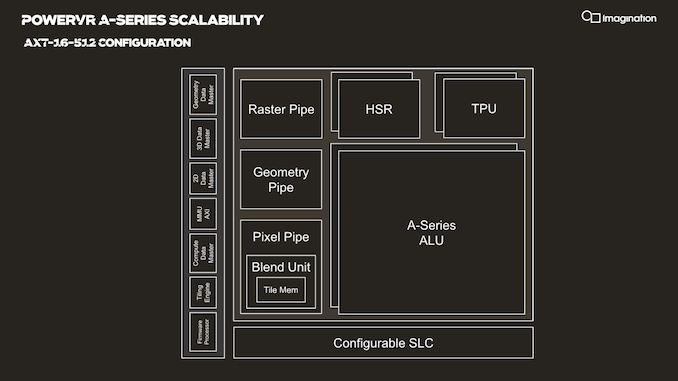
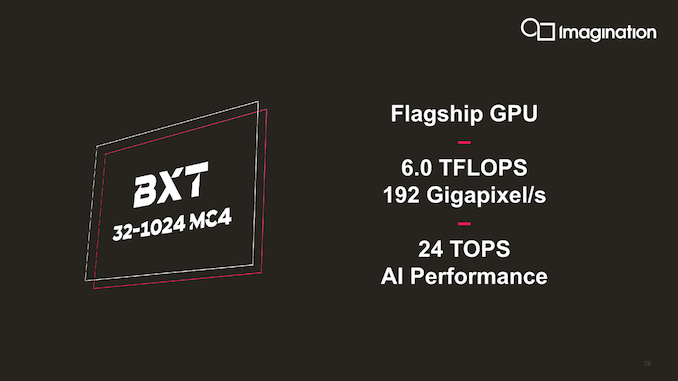
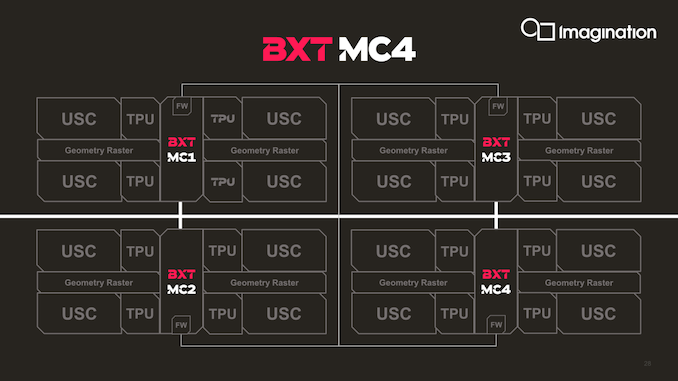
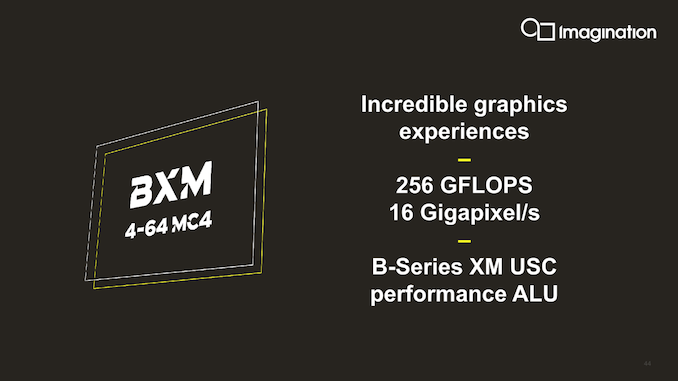
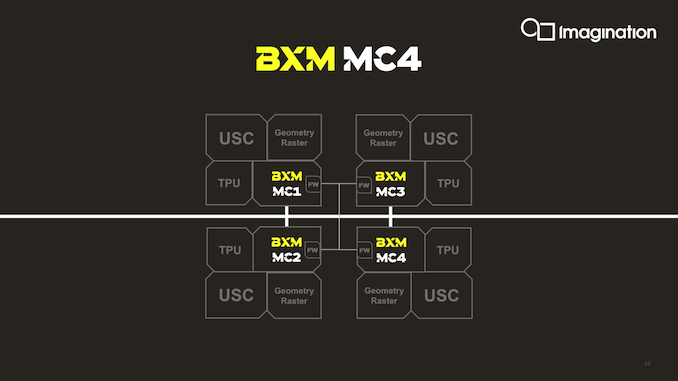
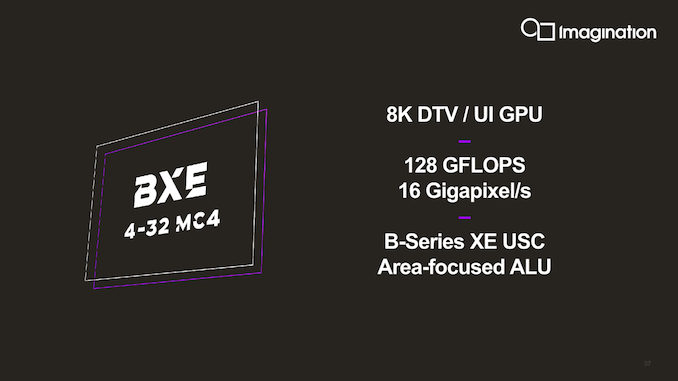
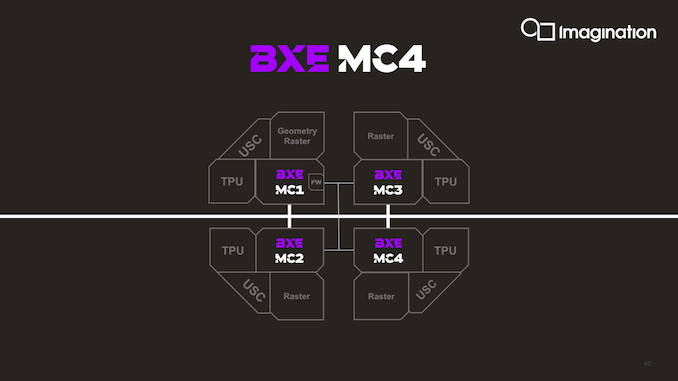








74 Comments
View All Comments
HVAC - Tuesday, October 13, 2020 - link
You don't win market share without a product offering in the market. If we only did things for which we could be certain of success, we would all still be huddled into a teeming mass near central Asia.EthiaW - Tuesday, October 13, 2020 - link
Since there has been no application of Imagination's top tier configurations after Apple abandoned them (from the Furian generation, 2017), leaving that market for small budget gpus, likely those in wearable devices will be justifiable.They having been working on high-end mobile gpus for some 5 years without market share, sadly.
Zingam - Wednesday, October 14, 2020 - link
This way of thinking, Mr.... that's why you are no Bill Gates.Yojimbo - Tuesday, October 13, 2020 - link
Because the Chinese have a lot of money to throw around and they desperately want to develop market-controlling technologies. They don't control that many Western IP companies. Might as well try to make use of the few they do control.Zingam - Wednesday, October 14, 2020 - link
I doubt that Chinese have that much money... They are just big. When you are big then you also spend more to support yourself.Yojimbo - Wednesday, October 14, 2020 - link
They have a huge amount of money. And they have a planned economy so they can strategically put it where they want. If they want to dominate 5G they can develop 5G IP, steal 5G IP, subsidize 5G equipment makers, etc., for example. The also have a yearly trade surplus of more than $400 billion. And they have an isolated financial system in which they can rack up a lot of debt, and foreign investors have been very happy to loan them money, anyway. They do spend a huge amount of money building useless infrastructure to pump up their GDP numbers and employ their citizens, but at the same time they are strategically developing, leeching, and stealing high tech design and manufacturing capabilities to attempt to dominate future technologies.dotjaz - Wednesday, October 14, 2020 - link
They don't have a planned economy. It's largely market-driven. You are kidding yourself if you think they can create and control the world's biggest single market.Certain industries are government controlled, yes, just like any western countries before privatization of utility services became a thing. And their sovereign fund is much bigger.
colinisation - Tuesday, October 13, 2020 - link
Still not sure why IMGTech was never just bought out by Apple or ARM. They seem to have some interesting tech.GC2:CS - Tuesday, October 13, 2020 - link
To my knowledge IMGTech got bid by Apple twice. But they refused.EthiaW - Tuesday, October 13, 2020 - link
Such a stubborn engineer-leaded company.